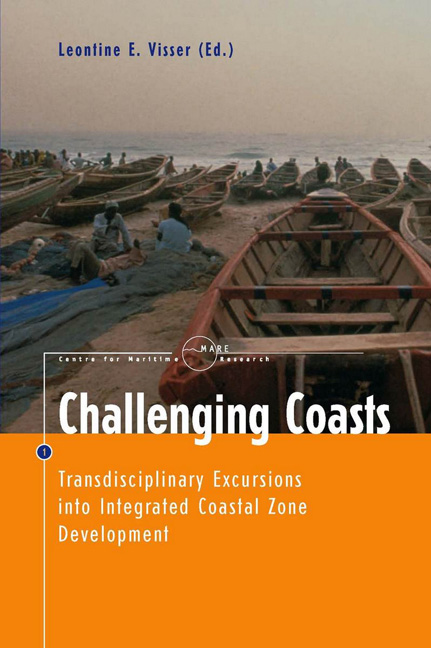Book contents
- Frontmatter
- Series Foreword
- Contents
- Acknowledgments
- 1 Introduction
- 2 Reflections on Transdisciplinarity, Integrated Coastal Development, and Governance
- 3 Biodiversity and the Natural Resource Management of Coral Reefs in Southeast Asia
- 4 A Concerted Approach towards Managing Living Resources in a Marine Protected Area
- 5 ‘Making Do’: Integrating Ecological and Societal Considerations for Marine Conservation in a Situation of Indigenous Resource Tenure
- 6 Basic Principles Underlying Research Projects on the Links between the Ecology and the Uses of Coral Reef Fishes in the Pacific
- 7 The Marine Implementation of the EC Birds and Habitats Directives: the Cases of Shipping and Oil Exploration Compared
- 8 Stakeholder Conflicts and Solutions across Political Scales: the Ibiraquera Lagoon, Brazil
- 9 ‘The Rich Eat Fish and the Poor Eat Pork’: The Decline of the Livelihoods of Handpickers of Aquatic Organisms in North Vietnam
- Index
- List of Contributors
9 - ‘The Rich Eat Fish and the Poor Eat Pork’: The Decline of the Livelihoods of Handpickers of Aquatic Organisms in North Vietnam
Published online by Cambridge University Press: 28 January 2021
- Frontmatter
- Series Foreword
- Contents
- Acknowledgments
- 1 Introduction
- 2 Reflections on Transdisciplinarity, Integrated Coastal Development, and Governance
- 3 Biodiversity and the Natural Resource Management of Coral Reefs in Southeast Asia
- 4 A Concerted Approach towards Managing Living Resources in a Marine Protected Area
- 5 ‘Making Do’: Integrating Ecological and Societal Considerations for Marine Conservation in a Situation of Indigenous Resource Tenure
- 6 Basic Principles Underlying Research Projects on the Links between the Ecology and the Uses of Coral Reef Fishes in the Pacific
- 7 The Marine Implementation of the EC Birds and Habitats Directives: the Cases of Shipping and Oil Exploration Compared
- 8 Stakeholder Conflicts and Solutions across Political Scales: the Ibiraquera Lagoon, Brazil
- 9 ‘The Rich Eat Fish and the Poor Eat Pork’: The Decline of the Livelihoods of Handpickers of Aquatic Organisms in North Vietnam
- Index
- List of Contributors
Summary
Introduction
Before any fishing gear was invented, men, women, and children used their hands and feet to capture fish and other aquatic organisms along the shores of rivers and seas. Over the years they developed artisanal fishing techniques to adapt to local conditions, the desired species, and the size targeted. The term ‘fishing’ does not exclusively refer to the catching of fish, instead it touches on the capture of all aquatic organisms (Brandt 1972:2). On Cat Hai Island in North Vietnam I found that people use, a variety of techniques to catch fish and other aquatic organisms (Van Duijn 2002). The focus of this paper is on the livelihoods and techniques of fishers who gather aquatic organisms with either their bare hands or by using simple gear (see fig. 9.1). The latter I consider to be tools that can be carried and operated by an individual alone. On Cat Hai Island this method for gathering molluscs (bivalves and gastropods), brachiopods, sipunculids, and crabs constitutes an important activity for the poorest local people in particular. As this manner of fishing invariably encompasses the use of one's hands to pick up the organisms, in this paper the terms handpicking, collecting, and gathering are used interchangeably to refer to this activity.
On Cat Hai Island the occupation of marine resource exploitation using active and passive gear has been declining in employment as well as production since at least as far back as 1990. In the case of most species that are or were handpicked, the inhabitants of Cat Hai Island easily gathered aquatic organisms prior to 1990. For instance interviewees reported being fed up with eating mud crab (Scilla serrata), which is currently the most valuable local crab species. Collected crabs were put into ceramic baskets and the fishers were not concerned about how many escaped. More recently, window shells (Placuna placenta) were gathered in such quantities that people put them in ponds near their houses so that they could gradually eat them.
Throughout the years aquatic organisms were collected mainly for consumption purposes and sometimes as an additional source of income from sale at a local market, but never as a main source of income. Local people handpicked aquatic organisms whenever they had an appetite for them or when food was scarce.
- Type
- Chapter
- Information
- Challenging CoastsTransdisciplinary Excursions into Integrated Coastal Zone Development, pp. 211 - 238Publisher: Amsterdam University PressPrint publication year: 2004



